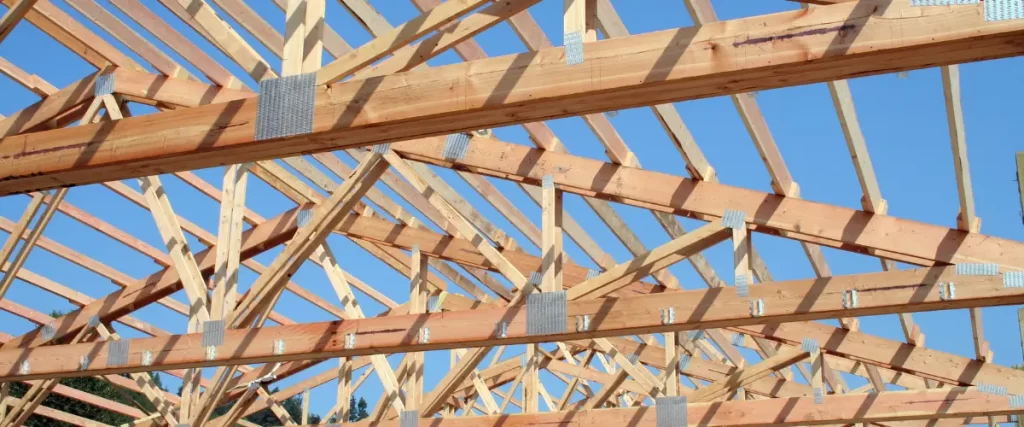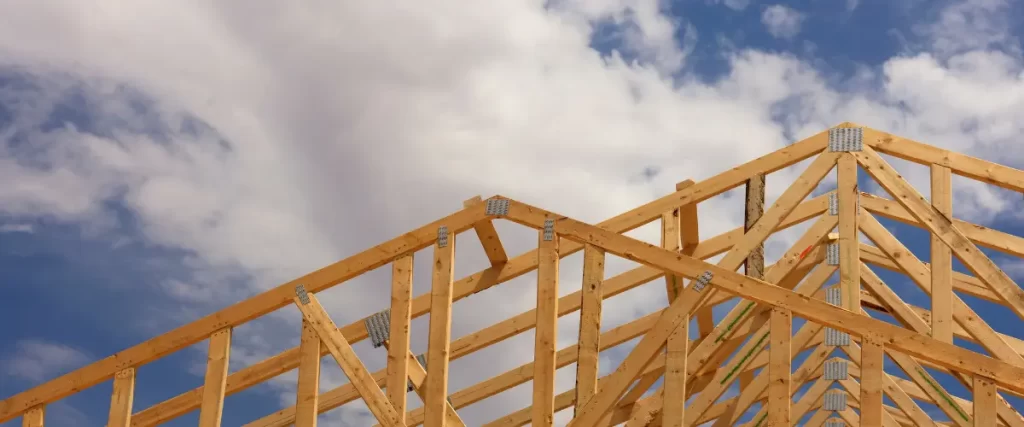Let’s talk about trusses—those cool, triangle-shaped structures that hold up roofs. You’ve probably seen them in houses, barns, or even big warehouses. But what exactly are trusses, why are they so important, and what types of trusses are best for which homes?
Basically, trusses are frameworks made of wood or steel that support the roof. They’re designed to handle weight, resist pressure, and keep everything sturdy and balanced. Think of them like the skeleton of a roof. Without them, the roof wouldn’t be able to stand up to rain, snow, or wind.
Now, there isn’t just one type of truss. There are many different kinds, and each one has its own purpose. Some are great for wide spaces, while others are perfect for homes with steep roofs. Some look super fancy, and others are more about function than style.
In this guide, we’re going to break it all down. We’ll talk about the most common types of trusses, what makes them special, and how they’re used. By the end, you’ll know exactly what kind of truss might work best for your next project—or at least impress someone at your next BBQ when the topic comes up!

1. King Post Truss
Let’s start with the king post truss—one of the simplest and oldest truss designs out there.
Picture a big triangle with a vertical beam right in the middle. That’s the king post. It connects the top point of the triangle (called the apex) to the base. This design makes it strong and stable.
Where is it used?
King post trusses are perfect for small spaces like sheds, garages, or even porches. Since they’re simple, they’re also budget-friendly and easy to install.
Why people like it:
- It’s affordable.
- It works well for short spans (about 5–8 meters).
- It’s straightforward and doesn’t need fancy tools to build.
2. Queen Post Truss
Next up, we’ve got the queen post truss. It’s like the king post truss, but instead of one vertical beam, it has two vertical posts.
These two posts give it extra strength, making it great for longer spans—think halls, barns, and small bridges.
Where is it used?
You’ll mostly see queen post trusses in medium-sized buildings. They’re a step up from king posts but still keep things simple.
Why people like it:
- It’s stronger than the king post truss.
- It can handle longer spans (up to 10 meters).
- It’s a classic design that’s been used for centuries.
3. Pratt Truss
Now let’s get into something a little more complex—the Pratt truss.
This one has diagonal beams that slope downward toward the center. It’s designed to handle compression (pushing forces) and tension (pulling forces) really well.
Where is it used?
You’ll find Pratt trusses in bridges, warehouses, and large roofs. It’s strong, efficient, and can handle a lot of weight without breaking a sweat.
Why people like it:
- It’s great for long spans (over 10 meters).
- It’s super efficient, which means less material and lower costs.
- It’s tough enough to handle heavy loads like snow and wind.
4. Howe Truss
The Howe truss is like the opposite of the Pratt truss. Its diagonal beams slope upward toward the center.
Because of this design, it handles compression forces better than tension, which makes it perfect for heavy roofs and bridges.
Where is it used?
Howe trusses are often used in railway bridges, factories, and buildings with heavy loads.
Why people like it:
- It’s sturdy and can handle big weights.
- It’s often used in steel construction, which adds extra strength.
- It’s flexible and works for both short and long spans.
5. Fink Truss
If you’ve ever seen a house roof, you’ve probably seen a Fink truss. It’s one of the most popular designs for residential buildings.
This truss has a bunch of smaller triangles inside the big triangle, which spreads out the weight evenly.
Where is it used?
Fink trusses are great for houses, garages, and commercial buildings. They’re lightweight but still strong enough to handle bad weather.
Why people like it:
- It’s affordable and easy to build.
- It works well for pitched roofs.
- It uses less material, which keeps costs down.

6. Scissor Truss
Ever seen a ceiling with a vaulted look? That’s probably thanks to a scissor truss.
This truss has beams that cross each other in the middle, creating a raised ceiling effect. It’s perfect if you want your space to feel open and airy.
Where is it used?
Scissor trusses are popular in churches, cathedrals, and modern homes where high ceilings are a big deal.
Why people like it:
- It creates a vaulted ceiling without extra framing.
- It adds a touch of style to any space.
- It’s strong and can handle medium to long spans.
7. Gambrel Truss
Now let’s talk about the gambrel truss—the one that looks like a barn roof.
It has two slopes on each side. The lower slope is steeper, and the upper slope is shallower. This design creates extra attic space, which is why it’s so popular in barns and storage buildings.
Where is it used?
You’ll see gambrel trusses in barns, garages, and storage sheds.
Why people like it:
- It creates more usable space inside the roof.
- It’s great for storage or living areas like lofts.
- It has that classic barn look people love.
8. Flat Truss
Not all roofs need slopes! The flat truss is exactly what it sounds like—a flat structure.
It’s simple and perfect for modern buildings or areas where slopes aren’t necessary.
Where is it used?
Flat trusses are common in commercial buildings, warehouses, and apartment complexes.
Why people like it:
- It’s perfect for modern designs.
- It’s easy to install.
- It works well for flat or low-slope roofs.
9. Fan Truss
The fan truss is all about spreading out weight evenly. It looks like a series of triangles connected to a central point, almost like the shape of a fan (hence the name).
Where is it used?
Fan trusses are great for industrial buildings, large halls, and auditoriums where the roof needs to cover a wide area without sagging.
Why people like it:
- It’s strong and balanced.
- It works well for large spans.
- It’s often used in steel construction, so it lasts a long time.
10. North Light Truss
The north light truss is designed to let in natural light. It has steep slopes on one side and shallow slopes on the other. These slopes allow for skylights or windows, making it perfect for spaces that need bright interiors.
Where is it used?
You’ll find these in factories, warehouses, and workshops where natural light cuts down on energy costs.
Why people like it:
- It’s great for energy efficiency.
- It provides plenty of natural light.
- It’s sturdy and practical for industrial use.
11. Bowstring Truss
The bowstring truss has a curved top, which gives it a unique look. It’s often used in buildings where style and strength both matter.
Where is it used?
You’ll often see bowstring trusses in airplane hangars, gymnasiums, and event halls.
Why people like it:
- The curved design is eye-catching.
- It’s perfect for large open spaces.
- It’s strong enough for big roofs.
12. Raised Heel Truss
The raised heel truss is built for better insulation. It has a taller section where it connects to the walls, leaving space for extra insulation.
Where is it used?
It’s mostly used in houses, especially in colder climates where insulation is super important.
Why people like it:
- It helps save energy.
- It’s great for insulated roofs.
- It’s simple and works for most residential homes.
13. Parallel Chord Truss
The parallel chord truss has two horizontal beams (chords) connected by diagonal supports. It’s a common choice for flat roofs.
Where is it used?
You’ll find these in commercial buildings, apartments, and industrial spaces.
Why people like it:
- It’s simple and cost-effective.
- It’s great for flat or low-slope roofs.
- It’s easy to install.
14. K-Truss
The K-truss gets its name because the beams form a K shape. It’s designed to handle heavy loads while using less material, making it both strong and efficient.
Where is it used?
You’ll see K-trusses in bridges and large buildings that need serious structural support.
Why people like it:
- It’s cost-effective.
- It’s strong enough for heavy loads.
- It’s great for large spans.
15. Trapezoidal Truss
The trapezoidal truss looks like a trapezoid instead of a triangle. It’s built for flat or low-pitch roofs and is super simple and functional.
Where is it used?
These trusses are popular in commercial spaces, warehouses, and factories.
Why people like it:
- It’s affordable and practical.
- It works well for modern designs.
- It’s easy to install.

FAQ – Quick Answers About Trusses
1. What’s the most common type of truss?
The Fink truss is the most common for houses because it’s affordable, simple, and strong.
2. What’s the best truss for big spaces?
For large spans, the Bowstring truss and Fan truss are great choices.
3. Can trusses handle heavy loads?
Yes! Howe trusses and K-trusses are built for heavy loads like snow and wind.
4. Which truss is best for vaulted ceilings?
The Scissor truss is perfect for vaulted ceilings since it creates an open, airy feel.
5. Are trusses expensive?
Trusses come in different price ranges. Simple ones like the King Post truss are more affordable, while larger ones like the Bowstring truss cost more because they handle bigger spaces.
Build Smarter with Conklin Construction
Choosing the right truss can make or break your roof’s design and strength. Whether you’re building a cozy home, a barn, or a massive warehouse, there’s a truss out there that fits your needs perfectly.
At Conklin Construction, we’re experts in helping you find the best trusses for your project. From classic designs like King Post trusses to modern styles like Scissor trusses, we handle it all.
We’re here to make sure your roof is strong, beautiful, and built to last. Contact Conklin Construction at (608) 839-0620 today and let’s build something amazing!
